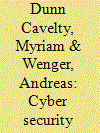| Srl | Item |
| 1 |
ID:
171960


|
|
|
|
|
| Summary/Abstract |
In the last decade, cyber incidents have become more expensive, more disruptive, and in many cases more political, with a new body of theoretically informed research emerging in parallel. This article provides the intellectual history to situate this literature in its broader evolutionary context. After identifying and discussing six drivers from the fields of technology, politics, and science that have been influential in the evolution of cyber security politics and how it is studied, we describe three historically contingent clusters of research. Using the same driving factors to look into the future of research on cyber security politics, we conclude that it is a vibrant and diverse biotope that is benefitting from its interdisciplinarity, its relevance for policy, and its cognizance of the interplay between technological possibilities and political choices of state actors.
|
|
|
|
|
|
|
|
|
|
|
|
|
|
|
|
| 2 |
ID:
163730


|
|
|
|
|
| Summary/Abstract |
This article sheds light on the complexity and sensitivity of crowd-based intelligence in security governance. The 'crowd’ as special manifestation of ‘the public’ is both challenging and enabling new forms of intelligence practices. As a spontaneous eruption of collective activity, the crowd is a notion of great versatility. Sometimes considered mad/dangerous, sometimes wise/useful, the crowd’s drivers are a context-dependent collage of (affective) group engagement, projection from the outside and the workings of digital technologies. The article traces how the existence of crowds in its variations is connected to how they are approached by security agents and their intelligence practices.
|
|
|
|
|
|
|
|
|
|
|
|
|
|
|
|